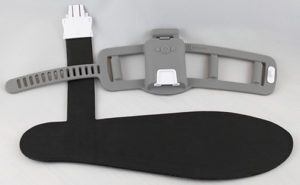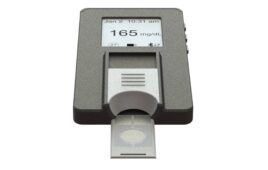
[Image from RxFunction]
A research study from Wingate University has tested the long-term benefits of using wearable technology company RxFunction’s Walkasins in people who have peripheral neuropathy.
“These exciting results have exceeded our expectations and illustrate how Walkasins can significantly improve the lives of millions of patients who experience gait and balance problems due to peripheral neuropathy,” said Lars Oddsson, co-inventor of the technology and president of RxFunction (Minneapolis), in a press release. “This is a game-changer that can improve health and quality of life and help decrease healthcare costs.”
Oddsson recently told MDO that the company is focused on getting Walkasins into Veterans Health Administration facilities; the company has taken advantage of federal Small Business Innovation Research grants.
Peripheral neuropathy is a condition that affects the peripheral nervous system. It is characterized by motor nerve damage, sensory nerve damage and autonomic nerve damage. About 20 million people in the U.S. have some type of peripheral neuropathy, according to the National Institute of Neurological Disorders and Stroke.
Walkasins have insoles that measure the foot pressure of the user and give immediate gentle and tactile sensory cues that help control balance and stability, according to the company.
The wearable device has 2 components – a leg unit and a foot pad. The leg unit is designed to wrap around the user’s lower leg and houses electronics for the foot pad readings. It also has a microprocessor and 4 vibrating motors. Walkasins are powered by an internal battery that can be charged through a micro USB port and connect to the foot pad through a physical cable.
A volunteer participant in the Wingate University study reported having dramatic changes once wearing the Walkasins.
“I put them on and it was like a miracle,” said Tim Kelley.
Sensory signals are restored in neuropathy patients when using Walkasins.
Researchers tracked Kelley’s gait and balance improvement with standardized measurement tools like the Functional Gait Assessment (FGA) and Mini Balance Evaluation System Test (Mini-BEST). The measurements on the two tests showed continued improvement after a month of use.
“We may be maxing out the FGA and Mini-BEST. He almost has perfect scores in them,” said Diane Wrisley, principal investigator on the study and director of post-professional programs for Wingate University’s Department of Physical Therapy.
Kelley has also shown improvements with self-confidence when measured on the Activities Specific Balance Confidence scale. According to the researchers, people who have a confidence score below 67% are predicted to have an 84% likelihood of falling. In Kelley’s case, his rating changed from 24% to 74%.
The study also reported that Kelley’s walking speed increased by more than 0.5 m/s.
“We’re thrilled to be able to report these results during Peripheral Neuropathy Awareness Week,” said CEO of RxFunction Dan Leach. “We’re energized by the exuberance shown by our trial patients and are looking forward to helping millions of people who have peripheral neuropathy with the release of Walkasins later this year.”
[Want to stay more on top of MDO content? Subscribe to our weekly e-newsletter.]





Where can i purchase these?